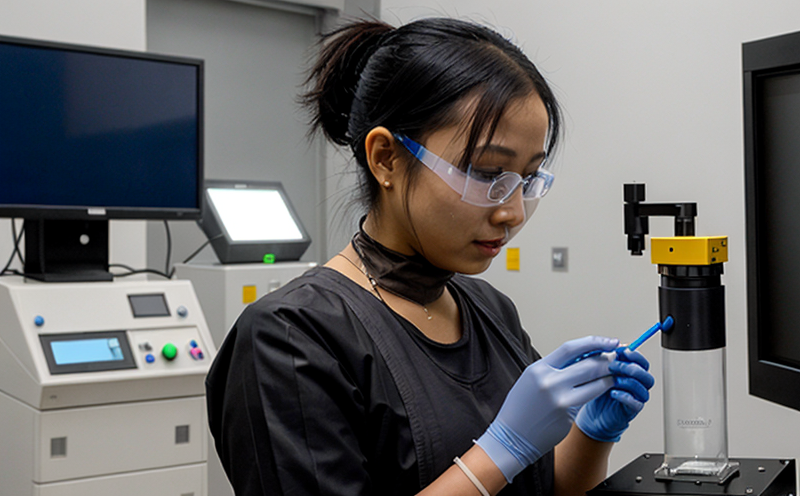ISO 13320 Particle Size Distribution of Nanomaterials in Environmental Samples
The ISO 13320 standard is a cornerstone method used by laboratories to determine the particle size distribution (PSD) of nanomaterials present in environmental samples. This service is particularly relevant for industries dealing with air, water, and soil where the presence of nanoparticles can have significant ecological or human health implications.
The PSD is critical because it influences how nanomaterials behave in different environments. For instance, smaller particles may exhibit increased reactivity or mobility, potentially leading to enhanced dispersion within aquatic systems or more rapid uptake by terrestrial organisms. Understanding these properties helps stakeholders comply with environmental regulations and manage risks associated with the release of nanomaterials into natural ecosystems.
Compliance with ISO 13320 is essential for organizations involved in research, development, manufacturing, and disposal of nanomaterials. By accurately measuring PSD, laboratories can ensure that products meet regulatory standards set by bodies like the European Chemicals Agency (ECHA) or the U.S. Environmental Protection Agency (EPA).
The testing process involves several key steps. First, samples are collected from relevant environmental matrices such as soil, water, or air and prepared for analysis. Specimen preparation is crucial to minimize bias in measurements; this includes homogenization techniques that ensure a representative sample. Once prepared, the nanomaterials within the matrix are then dispersed using appropriate solvents or aqueous media.
The primary instrument used for measuring PSD according to ISO 13320 is the laser diffraction spectrometer (LDS). This device operates by shining a laser through a suspension of nanoparticles and recording how much light passes through different sections. Particle sizes are calculated based on the intensity distribution of scattered light, allowing precise determination even at nanometer scales.
After acquisition, raw data undergo rigorous quality control checks to validate accuracy and precision. Acceptance criteria specify tolerances within which results must fall for a sample to be considered valid. If necessary, additional calibration exercises may be performed using reference materials provided by organizations like the National Institute of Standards and Technology (NIST).
Results are presented as histograms showing particle size distributions across specified ranges. These visual representations provide valuable insights into whether specific nanomaterials exhibit characteristics conducive to undesirable environmental behavior.
For instance, if a particular type of nanoparticle shows an unexpectedly high concentration of very small particles after treatment or exposure in natural conditions, this could indicate potential issues with manufacturing processes or storage practices that need addressing. Conversely, knowing the exact distribution helps refine product design for better performance while minimizing adverse effects.
The ISO 13320 method not only supports compliance but also facilitates innovation by providing data crucial for optimizing nanomaterial formulations tailored specifically to desired applications without compromising safety standards.
Benefits
Adopting ISO 13320 particle size distribution testing offers numerous advantages, including:
- Enhanced Regulatory Compliance: Ensures adherence to international guidelines and helps avoid costly penalties.
- Risk Management: Identifies potential risks early in the product lifecycle through detailed analysis of nanomaterial behavior.
- Innovation Support: Provides essential data needed for developing safer, more effective products without compromising quality or performance.
Organizations that invest in this service can gain a competitive edge by staying ahead of regulatory trends and ensuring their products meet the highest environmental standards.
Industry Applications
- Agriculture: Monitoring nanofertilizers to ensure they do not pose risks to soil health or groundwater quality.
- Solar Energy: Analyzing nanoparticle compositions in photovoltaic cells to enhance efficiency and durability.
- Water Treatment: Assessing the effectiveness of nanostructured filters in removing contaminants from drinking water sources.
- Consumer Products: Evaluating nanocoatings used in personal care items like sunscreens or cosmetics for stability and safety.
In each application, accurate PSD measurements play a pivotal role in ensuring product efficacy while mitigating environmental impacts.
Competitive Advantage and Market Impact
By offering ISO 13320 particle size distribution testing services, laboratories contribute significantly to their clients' ability to innovate responsibly. This capability allows organizations to:
- Stay Ahead of Regulations: By being prepared for future standards and guidelines before they become mandatory.
- Enhance Brand Reputation: Demonstrating commitment to sustainability and safety, which appeals increasingly to eco-conscious consumers.
- Increase Market Share: Differentiating themselves through superior product quality and reliability in a crowded market.
The detailed insights gained from this testing can also lead to improved internal processes, reduced waste, and lower operational costs—all contributing factors that strengthen competitive positioning.





